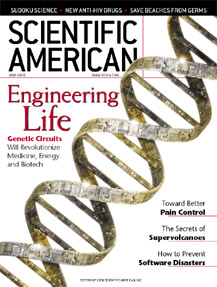The Flipping Point
How the evidence for anthropogenic global warming has converged to cause this environmental skeptic to make a cognitive flip

In 2001 Cambridge University Press published Bjorn Lomborg’s book The Skeptical Environmentalist, which I thought was a perfect debate topic for the Skeptics Society public lecture series at the California Institute of Technology. The problem was that all the top environmental organizations refused to participate. “There is no debate,” one spokesperson told me. “We don’t want to dignify that book,” another said. One leading environmentalist warned me that my reputation would be irreparably harmed if I went through with it. So of course I did.
My experience is symptomatic of deep problems that have long plagued the environmental movement. Activists who vandalize Hummer dealerships and destroy logging equipment are criminal ecoterrorists. Environmental groups who cry doom and gloom to keep donations flowing only hurt their credibility. As an undergraduate in the 1970s, I learned (and believed) that by the 1990s overpopulation would lead to worldwide starvation and the exhaustion of key minerals, metals and oil, predictions that failed utterly. Politics polluted the science and made me an environmental skeptic.
Nevertheless, data trump politics, and a convergence of evidence from numerous sources has led me to make a cognitive switch on the subject of anthropogenic global warming. My attention was piqued on February 8 when 86 leading evangelical Christians — the last cohort I expected to get on the environmental bandwagon — issued the Evangelical Climate Initiative calling for “national legislation requiring sufficient economy-wide reductions” in carbon emissions.
Then I attended the TED (Technology, Entertainment, Design) conference in Monterey, Calif., where former vice president Al Gore delivered the single finest summation of the evidence for global warming I have ever heard, based on the recent documentary film about his work in this area, An Inconvenient Truth. The striking before-and-after photographs showing the disappearance of glaciers around the world shocked me out of my doubting stance. Four books eventually brought me to the flipping point.
Archaeologist Brian Fagan’s The Long Summer (Basic, 2004) explicates how civilization is the gift of a temporary period of mild climate. Geographer Jared Diamond’s Collapse (Penguin Group, 2005) demonstrates how natural and human-caused environmental catastrophes led to the collapse of civilizations. Journalist Elizabeth Kolbert’s Field Notes from a Catastrophe (Bloomsbury Publishing, 2006) is a page-turning account of her journeys around the world with environmental scientists who are documenting species extinction and climate change unmistakably linked to human action. And biologist Tim Flannery’s The Weather Makers (Atlantic Monthly Press, 2006) reveals how he went from being a skeptical environmentalist to a believing activist as incontrovertible data linking the increase of carbon dioxide to global warming accumulated in the past decade.
It is a matter of the Goldilocks phenomenon. In the last ice age, CO2 levels were 180 parts per million (ppm) — too cold. Between the agricultural revolution and the industrial revolution, levels rose to 280 ppm — just right. Today levels are at 380 ppm and are projected to reach 450 to 550 by the end of the century — too warm. Like a kettle of water that transforms from liquid to steam when it changes from 99 to 100 degrees Celsius, the environment itself is about to make a CO2–driven flip.
According to Flannery, even if we reduce our carbon dioxide emissions by 70 percent by 2050, average global temperatures will increase between two and nine degrees by 2100. This rise could lead to the melting of the Greenland Ice Sheet, which the March 24 issue of Science reports is already shrinking at a rate of 224 ±41 cubic kilometers a year, double the rate measured in 1996 (Los Angeles uses one cubic kilometer of water a year). If it and the West Antarctic Ice Sheet melt, sea levels will rise five to 10 meters, displacing half a billion inhabitants.
Because of the complexity of the problem, environmental skepticism was once tenable. No longer. It is time to flip from skepticism to activism.

